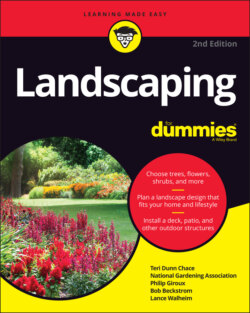Читать книгу Landscaping For Dummies - Lance Walheim - Страница 45
Playing with Color
ОглавлениеColor in your home landscape, just like color indoors, creates moods and impressions. Because your canvas is a living canvas, you can experiment, make discoveries, change your mind, tweak and tinker, and … honestly … have fun. Refer to the color insert to spark your imagination on how you can use color in your design.
Hot colors — bright pink, yellow, orange, and orange-red — jump out at you, making distances seem shorter. Cool colors — blues, purples, deep reds, and pastels — recede, making spaces seem longer. If you want to make a small yard seem bigger, plant hot colors at the entryway and cool colors across the garden at the far end where they’ll look like a misty watercolor painting.
To make wide-open spaces seem smaller, plant bright, hot colors across the way, where they’ll seem to jump forward. Just be sure to choose colors in the same palette. You can use vivid orange and golden yellow dahlias at a gate, for instance, and then soften the hue into apricot and pale lemon yellow as the plantings recede.
This principle also applies to nonplant items, of course. We discuss garden decor and accessories in the section “Adding Décor to Your Design: How Many Pink Flamingos Are Enough?” later in this chapter, but we want to mention that if you want something like a compost pile, tool closet, or storage shed to recede from attention, choose or paint it a darker color.
Here’s a garden-color overview with a few brief notes on combinations to jump-start some ideas for you:
Purple: Majestic and dramatic, purple has a lot of power. What you may not realize is that it can play the role of garden peacemaker; it has the ability to marry colors that otherwise don’t get along. However, purple can get lost in shade, unless you pair it with a light-color companion.
Blue: In any hue, blue looks great with its opposite, orange. It also mixes well with yellow and pink. Blue brings a cooling, calming influence to garden displays.
Yellow: Radiant yellow is wonderful for brightening dim areas, and it’s always so cheerful in the sunshine, on its own, or mixed with other bright colors. Don’t overlook pale creamy yellow, which is lovely and calming among pastels.
Orange: Often fiery and fun, orange also gains sophistication in the company of purple. Combining it with lime green brings out the yellow values in both hues. Orange and white together is also refreshing. Paler versions of orange are beautiful with silver-leaved plants.
Red: Energizing red is amazingly versatile. Partner it with silver or white, and the result is rich and calming. Use it as an accent in a sea of green, and the whole display wins. Or create a bed of red variations from russet to maroon to burgundy, and the result is sultry.
Pink: Because pink is so variable, you have lots of possibilities when you use it. It’s a favorite in pastel displays and is especially nice with any shade of blue. It doesn’t, however, look great next to yellow (you can get a clichéd grocery-store bouquet look) or red (both look a bit flat). Silver and green, though, are great companions.
White: Okay, we know, white isn’t literally a color, but white in your landscaping is often welcome in complex or larger landscapes, giving a spirit of simplicity or purity. (An all-white garden bed can be pretty awesome.) It’s especially suited to gardens that are enjoyed in the evening hours, when it glows. Place white at the end of a path or the back of your yard to add depth.
Silver: Like white, silver stands out in the evening hours. But it’s also a wonderful daytime team player, often used as a light-catching foil to other colors, and with good reason, because it both highlights and unifies. We find it has the ability to bind together complex displays. It looks pretty with blue and purple. It does, however, look leaden on rainy days.
Green: Yes, green is a color in a landscaping design. From pale green to lime green to blue-green to rich, forest green, you have so many variations. If you deploy green with imagination and care, the effects can be downright fabulous, which is true everywhere from small potted displays to elaborate shrub borders and foundation plantings. Green is the great garden unifier and often the dominant color, so we urge you to explore and appreciate it.
